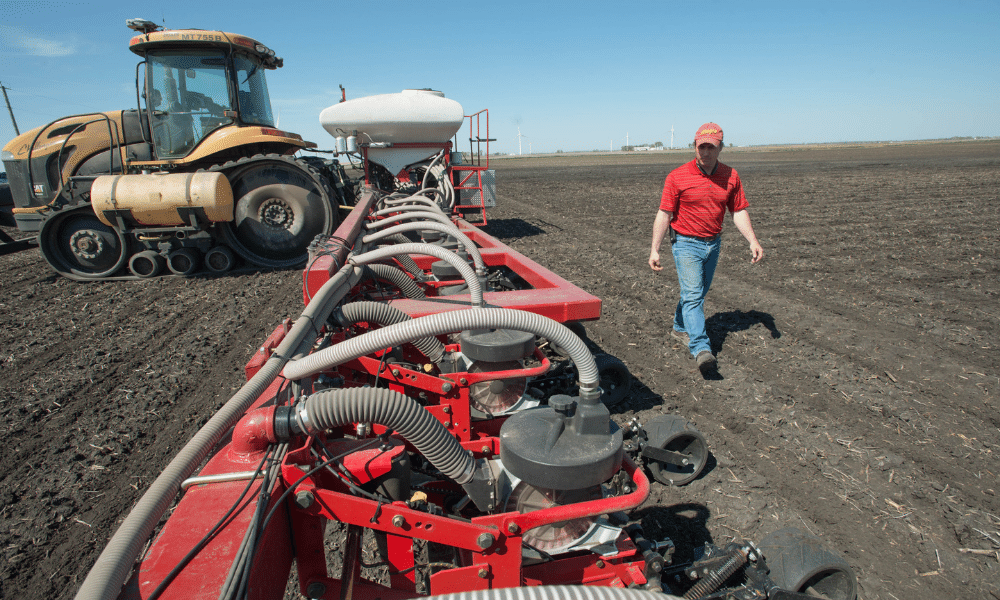
A.J. Blair is working with ISA researchers to learn more about an innovative system of drainage water recycling. (Photo: Iowa Soybean Association)
Transforming Ag Drainage: Farmers take a new look at water management
May 5, 2021
By Darcy Maulsby, ISA Communications contributor
If you’re like most Iowa farmers, you have areas in your fields that never seem to drain well. What if you could put that water to work for you?
A.J. and Kellie Blair are partnering with Iowa Soybean Association (ISA) researchers to see how their Dayton-area farm can benefit from an innovative system of drainage water recycling. “As a farmer, you’re always cussing the weather, because it’s never right,” A.J. Blair says. “I always thought we didn’t need irrigation, but it would be cool to have water at the right time.”
The Blairs have started transforming a 3-acre area on their farm into a holding pond. The excess water captured in the pond will be used in a pivot-irrigation system during drier parts of the growing season.
The Blairs are working with Chris Hay, Ph.D., an ISA senior research scientist, to implement a new resource called Evaluating Drainage Water Recycling Decisions (EDWRD). This tool helps farmers estimate the potential benefits of capturing drained agricultural water in ponds or reservoirs. This water can be used for irrigation, either with a center-pivot system, sub-irrigation or drip irrigation.
“What if we take a new look at drainage?” Hay says. “What if we don’t just remove excess water, but store it and use it when the crop needs it? That’s what drainage water recycling is all about.”
Financial Benefit
Drainage water recycling isn’t a new idea. University researchers began studying these systems in the 1980s and 1990s, Hay notes. Greater interest in water quality today, however, is spurring renewed interest in the concept.
ISA has been researching drainage water recycling since 2015. The data show that ag drainage recycling boosts yield potential and protects downstream water quality by managing nitrogen and phosphorus levels. “While a lot of water quality practices don’t benefit farmers financially, drainage water recycling does,” Hay says. “It’s a combination of multiple win-wins.”
The ISA Research team is testing EDWRD and drainage water recycling systems through pilot projects around Iowa in 2021. “Each system is unique and is designed to fit the landscape,” Hay says.
On the Blair’s farm, the drainage water recycling system will tap into a drainage district main that runs under the field. “We’re building some levees and adding a sump pump that will transfer water to the reservoir,” Hay says.
The size of an earthen, clay-lined reservoir depends on the area the farmer wants to irrigate. ISA uses field data and soils information to help determine the size of the reservoirs for the farms in the 2021 pilot projects. If the system is designed for 4-to-6 acre inches, for example, the volume of water applied would cover an area of 1 acre to a depth of 1 inch. “A few extra inches of water could come in handy when corn is pollinating or soybeans are flowering,” Hay says.
Irrigation opens up additional farm management options, too, including the ability to fertigate. “This lets you spread out nitrogen applications during the growing season,” Hay says.
Boost soil, plant health
The benefits don’t stop there. Proper drainage enhances soil health and plant health. “Lowering the water table allows more oxygen in the soil profile and promotes better root growth,” says Darla Huff, agriculture market manager, North America, with Advanced Drainage Systems (ADS), Inc. “Properly drained soil means less compaction, which allows roots to penetrate deeper into the soil.”
Healthy roots lead to efficient nutrient uptake, which contributes to more bushels at harvest. “With proper drainage, we consistently see increases in yields,” Huff says. “It’s not unusual to see up to a 20% to 30% yield increase for corn and soybeans.”
Ag drainage is a much more eco-friendly practice than it gets credit for, adds Willie Ubben Jr., who co-owns Ubben Tiling, Inc. at Stratford. “It’s a big misconception that tiling leads to flooding. It actually helps control runoff.”
Ubben installed one of the first bioreactors in Hamilton County about 15 years ago. He’s also a fan of Conservation Reserve Enhancement Program (CREP) wetlands and saturated buffers, which improve water quality while offering habitat for geese and other wildlife. “I’ve been in this business 25 years and have seen how farmland improvement and water quality go together.”
Offsetting the cost
While water management systems are effective, they require an investment. Drainage water recycling programs often start in the $250,000 range, Hay says.
ISA has been working with the Natural Resources Conservation Service (NRCS) so drainage water recycling is eligible for the Environmental Quality Incentives Program (EQIP). “The Iowa Department of Agriculture and Land Stewardship is also interested in cost-share programs for the reservoirs, since they capture nitrogen and phosphorus and prevent it from going downstream,” Hay says.
Going forward, water management systems may become part of ecosystem markets that can pay for farmers. “While carbon sequestration is the big thing now, conservation-minded investors are also interested in water quality markets,” Hay says.
Until then, drainage water recycling offers farmers like Blair an immediate benefit. “This has the potential to increase yield while taking some nitrogen out of the water, cleaning it and returning it back on to the field. We don’t need 20 inches of water to irrigate, but 2 inches at pollination could be huge.”
This story was originally published in the Spring 2021 issue of the Iowa Soybean Review.
Back